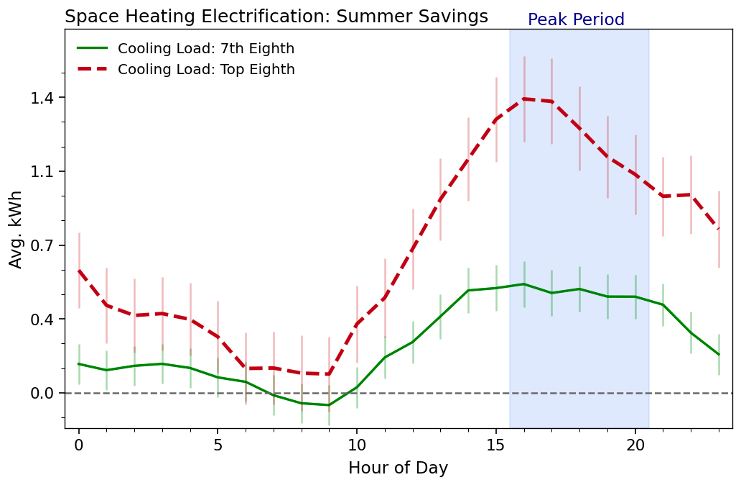How Targeting Can Transform Electrification Initiatives
Study finds top 25% of targeted heat pump customers are delivering nearly all the summer peak reductions.
February 27, 2024
(This article was originally published by Recurve, a TECH Clean California partner, and has been adapted here.)
TECH Clean California's meter-based customer targeting ensures that decarbonization efforts reach the customers who will benefit and provide grid value now, setting the stage for future success. A recent analysis of nearly 2,000 heat pump installations demonstrates how meter data can yield actionable insights to help electrification programs optimize their outreach, ensuring that heat pump installations save money for customers, reduce greenhouse gas emissions, and provide value to the grid.

The analysis showed how the 25 percent of identified customers who used the most air conditioning in the summer saved substantially more and provided much greater value to the grid by switching to a heat pump — even when considering increased electricity use for heating in the winter.
Targeting high-value customers like these in an electrification program is a no-regrets strategy to ensure that heat pump programs leverage their limited budgets to reach customers who receive and provide the most value. In addition, this strategy avoids outreach to potential heat pump customers who could see their overall energy bills go up.
Early Findings from the TECH Clean California Data Platform
Key Benefits:
- Grid Reliability - Enables utilities to forecast grid impacts and orchestrate electrification programs to maximize grid stability and efficiency
- Decarbonization - Ensure that electrification maximized GHG reductions based on forecasted hourly GHG impacts.
- Data-Driven Programs and Markets - Equip program providers with actionable insights drawn from trillions of smart meter data points.
- Energy Equity - Ensure that electrification strategies, especially for low-income customers, result in lower energy bills, circumventing potential equity challenges.
The TECH Clean California data platform is a first-of-its-kind data platform, capable of embedded measurement and data-driven decision-making. The platform will soon be tracking the savings (resource curve), grid and greenhouse gas (GHG) impacts, and bill savings for thousands of heat pumps statewide.
In its first phase, the TECH Clean California data platform is tracking 1,945 PG&E service area projects. 1,603 were heat pump HVAC projects with no solar behind the meter. Of those, 633 are “mature,” defined as having a full year of post-installation meter data available.
The following figure shows the electric load shape impacts of space heating electrification for an average non-solar residential customer. The top panels show the average daily observed load shape and counterfactual (“business as usual” consumption) after a customer received a heat pump installation. Three seasons are broken out from left to right: winter, shoulder, and summer. The bottom three panels show the corresponding savings profiles, which differ between the counterfactual and the actual usage.

In the winter, customers use more electricity as they heat their homes, particularly in the morning. The shoulder months show a similar effect, though much less, given the milder weather. In the summer, the heat pump systems provide more efficient air conditioning, yielding positive midday and peak savings.
Targeting High Air Conditioning Customers Delivers Peak Savings

Breaking customers up into quartiles based on summer cooling yields very interesting results when one analyzes summer peak savings.
For customers in the first three quartiles, changes in peak electricity demand ranged from a significant increase to a slight decrease. However, customers in the top quartile of baseline cooling load are achieving high summer peak savings (524 ± 42 kWh). With improved air conditioning efficiency, customers in this group generate an average of nearly $1,500 in electric utility avoided costs despite electrifying their space heating. The increase of 1.9 tons of electric-only GHG emissions among these customers is also far less than the portfolio average.
The top quartile can be segmented further by baseline cooling load, and doing so makes clear that a high ceiling exists for beneficial space heating electrification. The top eight cooling users save more than 750 kWh during the summer peak. These users also drove nearly $2,500 in lifecycle electric grid value while having almost zero net GHG impact from the electric impacts alone. Combined with the grid and GHG benefits of gas savings, these cooling-burdened users carry extremely high potential benefits from electrification.

These results indicate that focused electrification is a win-win-win for utilities, ratepayers, and participants. There are nearly two million residential customers in California who meet this profile of high air conditioning loads. These customers can save enough during peak hours to help stabilize the grid and save on their bills – not to mention they will achieve enormous gas and GHG savings by electrifying their space heating.
Electrification is critical to decarbonizing our buildings and using clean, renewable electricity on the grid. As electrification initiatives accelerate, meter-based customer targeting will help make the most of our investments now, and transform the market for the future.
You can learn more about these results by reviewing our October 2023 webinar presentation or the Data Reporting section of our website.
